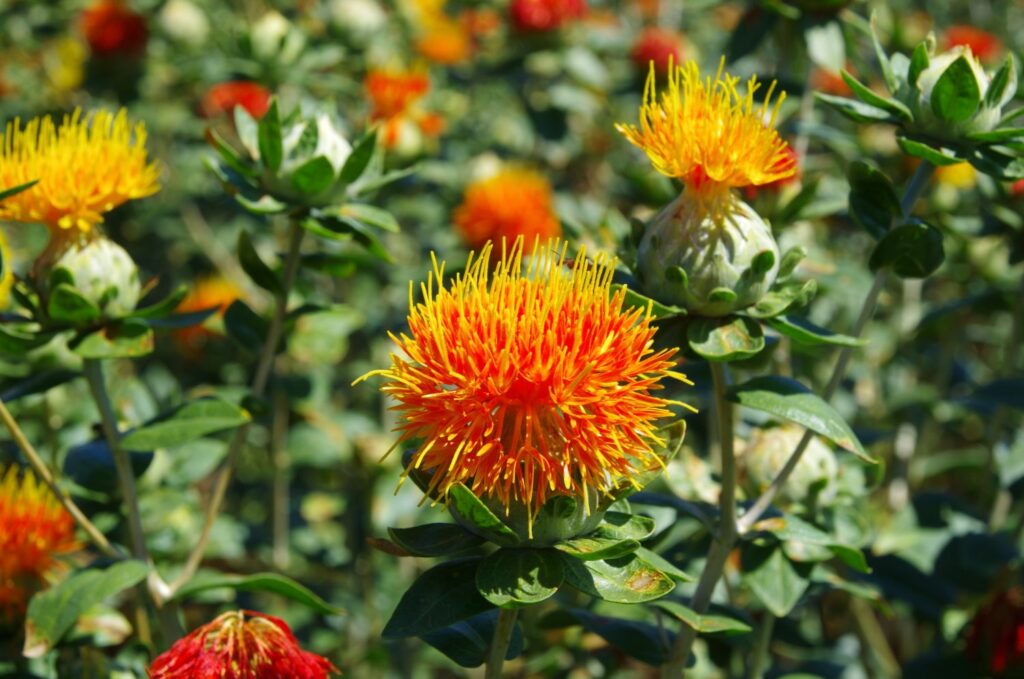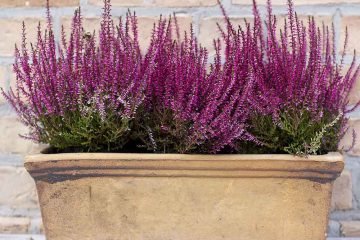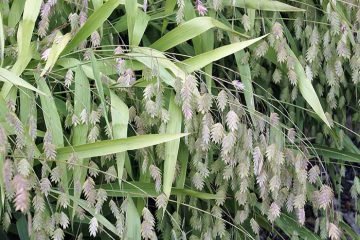Safflower plant specifications
Safflower plant
- Scientific name : Carthamus tinctorius
- Other names : American saffron, oil thistle, false saffron, dyer’s saffron, majestic orange, zaffer and Mexican saffron
- Order : Asterales
- Family : Asteraceae
- Genus : Carthamus
- Species : C. tinctorium
Safflower with Scientific name Carthamus tinctorius, is a highly branched, herbaceous, thistle-like annual plant in the family Asteraceae. Safflower is also known by other names such as American saffron, oil thistle, false saffron, dyer’s saffron, majestic orange, zaffer and Mexican saffron. It is hard to pinpoint the exact origin of the safflower as it is widespread throughout the world, but it is widely assumed that it originated in Anatolia.
The plant in its current form, Carthamus tinctorius, is probably a hybrid cultivated from the cross-breeding of the species Carthamus persicus and Carthamus palaestinus at some point in the distant past. We know that the plant was used for dyeing textiles in Egypt as early as 3500 BC.
read more : Everything about pot marigold flower : How to Plant & care for them

Although safflower is an annual plant, in the tropics and subtropics it has been known to overwinter. In Central Europe, however, the specimens that germinate in autumn usually do not make it through the winter. Only spring seedlings will flower in the same year. Its slightly branched main stems reach 60 to 130 cm in height and form a rosette of leaves.
The elongated safflower leaves are vibrant green in colour and have spiked edges. Depending on the species and variety, the spiny tips are more pronounced or less. At the end of each shoot is a thistle-like flowerhead made up of 20 to 150 yellow-orange tubular florets. The distinctive bulb-shaped flowers bloom from June to August, offering bees, bumblebees and other insects a rich supply of nutritious nectar and pollen.
Safflower Information
Safflower has an extremely long taproot which enables it to reach deep into the soil to retrieve water. This makes safflower a perfect crop for arid farming areas. Of course, this deep rooting for water uptake does deplete the available water in the soil, so sometimes the area will need to lay fallow for up to 6 years to replenish the water levels after growing safflower.
Safflower also leaves very little crop residue, which leaves fields open to erosion and is susceptible to several diseases. That said, the demand from our heart-healthy nation is such that the price garnered is well worth growing safflower as a cash crop.
read more : Everything about yarrow flower : How to Plant & care for them
Safflower Origin
Based on the existence of its close related species, safflower was believed to be originated in an area bounded by the eastern Mediterranean and Pesian Gulf, encompassing southern parts of former USSR, Western Iran, Iraq, Syria, Southern Turkey, Jordan and Israel.
Presently, safflower is cultivated on a commercial scale mostly in India, USA, Mexico, Ethiopia, Australia, China, Argentina, Russia and to a limited extent in Pakisthan, Italy, Spain, Portugal and Iran.
How to Grow Safflower
The ideal growing requirements for safflower are well-drained soils with good water retention, but safflower isn’t picky and will grow in coarse soil with inadequate irrigation or rain. It doesn’t like wet feet, however. Safflower is seeded in early to late spring. Plant seeds ½ inch (1.5 cm.) deep in rows that are 6-12 inches (15-30.5 cm.) apart in a prepared firm bed. Germination takes place in about one to two weeks. Harvesting occurs about 20 weeks from planting.
Export of dried safflower plant in Iran
Export of dried safflower plant to European countries has increased foreign customers for this product. Dried safflower is exported to Turkey, Iraq and Germany in suitable packaging. Countless medicinal plants , including safflower, have high exports in the country because Iran, due to its favorable climate, is the cradle of medicinal plants and plants produced in the country are of high quality.
Dried safflower , in addition to its decorative aspect, has many usages in traditional medicine and pharmacy. The reasonable price of dried safflower plant has caused the purchase and sale of dried safflower and other dried flowers for export to bring great profits to the exporters and wholesalers of dried safflower plant , and in this way, it will also help the country’s economy and currency.

read more : Drying natural flowers | Introducing 8 wonderful ways to dry flowers
Safflower Care
Safflower usually does not need additional fertilization at least in the first year of growing because the long taproot is able to reach and extract nutrients. Sometimes a supplemental nitrogen-rich fertilizer will be used. As mentioned, safflower is drought tolerant so the plant does not need much in the way of supplemental water.
Keep the safflower growing area free from weeds that compete for water and nutrients. Monitor and control for pest infestation, especially in the early part of the growing season when they can decimate a crop. Disease is most common during the rainy season when fungal diseases may be a problem. Many of these diseases can be managed through the use of disease-resistant seeds.
-
Location
Safflower needs warm and dry location to grow. Plant it on the sunniest location of your garden facing south or west. You can also grow it on sloping areas.
read more : Introduction of Iran medical plant
-
Soil
Soil must be deep, well drained and loamy. Amend your soil before planting if it is heavy and clay rich. If your soil is sandy, mix peat moss and compost to it. Safflower has less requirements regarding the pH, it prefers neutral soil.
-
Watering
Economical watering is required for growing safflower as it tends to develop rot and fungal diseases due to excess watering. When you water also take care not to wet the foliage as it can promote diseases.
-
Pests and Diseases
Its main problem is moisture that leads the plant to root rot and slow growth. Main diseases and pests are safflower rust, bacterial belight and aphids, leaf eating caterpillar and safflower fly.
Harvesting
Harvest safflower seeds when the plants begin to turn brown. Cut the seed heads and shake them in a bag or jar or open them using hand. Store them in a airtight container in cool and dry place.
Safflower petals are edible and are used to add color to food. Harvest the safflower petals when the flowers are fully open. Either remove the whole flower or pick off the petals.
Notice : This article translated by google form Persian language. If you have any question or need more information please contact us or add a comment at the bottom of this page.



0 Comments